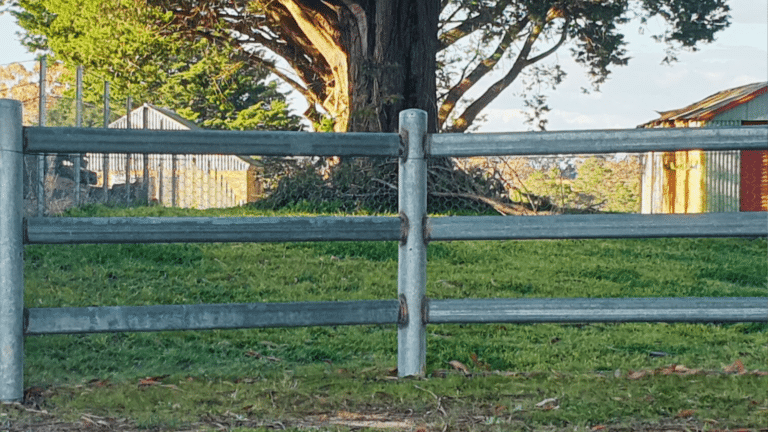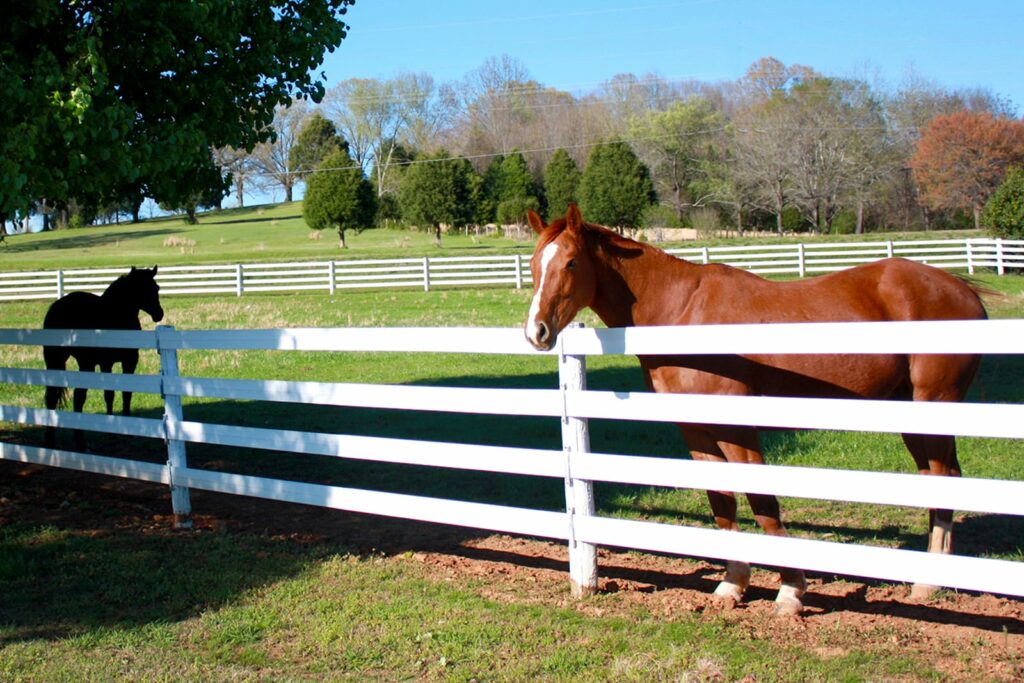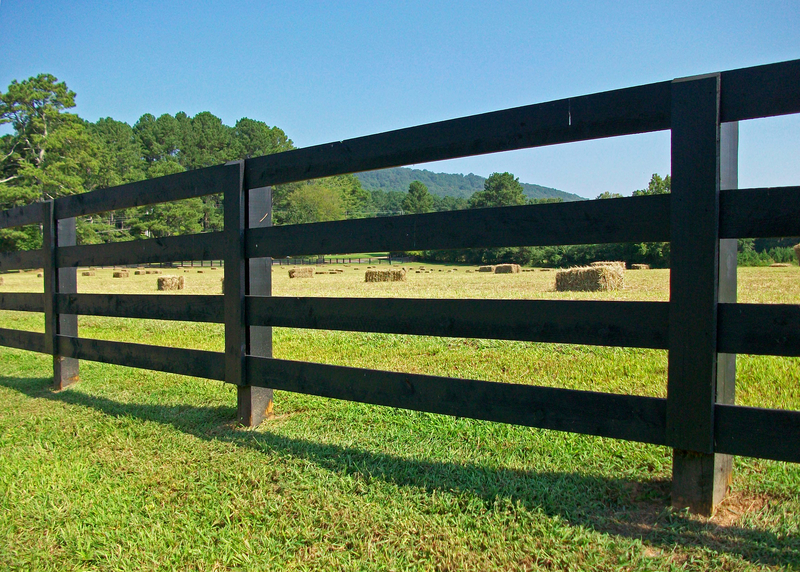Stock & Noble
Honest review of Cattle Rail – Pros and Cons of Steel Post and Rail Fencing.

- BY Tripti Kakkar
Cattle Rail, also known as steel pipe fencing or tubular fence, is a popular choice for agricultural fencing, particularly for containing livestock such as cattle, horses, and sheep.
If you’ve searched your way through the different types of steel post and rail fencing solutions and have chosen Cattle rail fencing then keep reading.
It’s a long-lasting fencing solution. Before you say yes to the fence, it’s important to ensure Cattle Rail is the right fencing for your property. So, you don’t end up wasting your time, effort and energy on the wrong product.
At Stock and Noble, we provide high-end property owners across Australia and New Zealand with the finest fencing solutions. Premium Steel Post and Rail Fencing – Buckley, is our flagship product chosen for its global success and proven safety. Based on insights gained from numerous client projects and years of interaction with experts on the ground, we have in-depth knowledge and expertise in the entire steel post and rail fence category.
In this article, we will delve into an honest and comprehensive review of Cattle Rail to make an informed decision about its suitability for your specific fencing needs.
Before the introduction of premium steel post and rail fencing solutions like Buckley in Australia, Cattle Rail served as the primary steel fencing option, earning its popularity among high-end properties across the country.
It is a pre-galvanized steel fence that doesn’t require additional painting or powder coating on top. This type of fencing has gained a reputation for its exceptional durability, making it a preferred choice for those seeking a long-lasting option.
While it has proven its reliability over the years, it is crucial to understand both the advantages and disadvantages of Cattle Rail.
Advantages of Cattle Rail: Steel Post and Rail Fencing
1. Consistent Appearance Over Time
Cattle Rail offers the advantage of maintaining a consistent appearance over the years. Even if you decide to make changes or expand your project in the future, Cattle Rail will always be available with the same look. This ensures that your fence will have a cohesive and uniform appearance, regardless of any modifications made over time. Additionally, Cattle Rail is a common and readily available fencing option, making it convenient to source and match existing installations.
2. Social Proof and Reliability
Cattle Rail has a strong social proof and reliability factor. As premium fencing options like Buckley or Horserail were not available 30 years ago, Cattle Rail became the go-to alternative to timber fencing. Many property owners turned to Cattle Rail when timber was unsuitable, resulting in numerous successful installations. This widespread use and positive track record provide confidence and peace of mind, as Cattle Rail has stood the test of time and proven its effectiveness.
3. Accessibility and Customisation
Cattle Rail is easy to obtain, making it a convenient choice for many fencing projects. It is readily available, ensuring that you can easily purchase more fencing materials if needed. Additionally, while customisation options for Cattle Rail may be somewhat limited compared to other fencing alternatives, there are still different options available for posts and some variations of Cattle Rail itself.
This allows for a certain level of customisation to suit your specific requirements and preferences. For instance, if you have an equine property, it can be adjusted in terms of height, rail spacing, and overall design to meet the needs of different horses or adapt to the landscape’s gradients.
4. Freedom to Choose Colours
One of the advantages of Cattle Rail is the ability to paint it in any colour you desire. This provides flexibility in matching the fence to your property’s aesthetics or incorporating it into existing design elements. You can choose a colour that complements your surroundings or opt for a bold statement colour, giving you creative freedom when it comes to the visual appeal of your fence.
We recommend using high-quality steel paint for your Cattle Rail and it’ll be worth reading a detailed comparison of steel fence paints to find the perfect one for your need and budget.
5. Strength and Durability
Cattle Rail is known for its strength and durability. It is a robust fencing option that can withstand the rigours of agricultural use. The sturdy steel construction ensures that it remains intact and provides reliable containment for your livestock. Unlike other materials, Cattle Rail doesn’t rot, making it a long-lasting choice for your fencing needs. Furthermore, it is resistant to damage caused by horses’ chewing habits, ensuring that your fence remains intact and secure.
6. Enhanced Security
Cattle Rail fencing enhances the security of livestock by deterring potential predators and unauthorised individuals. The visible and robust fencing acts as a deterrent, reducing the risk of theft or harm to animals.
7. Longevity
With proper maintenance, Cattle Rail post and rail fencing can have a long lifespan. Steel fencing, when well-maintained, can withstand the test of time without significant deterioration.
Disadvantages of Cattle Rail: Steel Post and Rail Fencing
1. Lack of Aesthetics
Cattle Rail is often perceived as being lifeless, boring, and purely functional in appearance. It may not have the impressive or visually appealing qualities that some other fencing options offer, like Premium Steel Post and Rail fencing, particularly for high-end properties.
This is primarily due to its common usage in practical settings such as sheep yards and cattle yards, where aesthetics are not the primary focus. Consequently, it may be seen as an everyday product rather than a premium choice for enhancing the overall look of a property.
The focus of Cattle Rail is primarily on functionality and durability, which may not align with certain aesthetic preferences.
2. Rusting Issues
One of the drawbacks of Cattle Rail is its susceptibility to rust. Over time, exposure to the elements can cause the steel material to corrode and develop rust. This can impact the fence’s structural integrity and aesthetics. Regular inspection and maintenance, such as applying protective coatings or addressing rust spots promptly, are necessary to mitigate this issue and ensure the fence’s longevity.
3. Potential for Horse Injuries
Due to its rigid construction, Cattle Rail may pose a risk of injury to horses. Unlike some other fencing options that have a certain level of flexibility or give, Cattle Rail lacks this characteristic. Horses that come into contact with the fence may experience injuries or discomfort. It is crucial to consider the safety of horses and evaluate alternative fencing options that provide a more suitable level of flexibility and cushioning to prevent such injuries.
4. Higher Initial Cost
Cattle Rail may be more expensive compared to other fencing options, especially when using Australian made quality steel. The initial investment in materials and installation might be higher, although the long-term benefits and durability can offset these costs.
5. Specific Maintenance Requirements
Cattle Rail requires some maintenance, specially checking for areas which are beginning to rust, and taking adequate measures for controlling corrosion.
Is Cattle Rail, the Right Steel Post and Rail Fencing Right for My Property?
Now you know Cattle Rail offers several advantages, including consistent appearance, social proof, accessibility, customisation, colour options, and durability. However, it also has its drawbacks, such as its perceived lack of aesthetics, rusting issues, and potential for horse injuries.
The choice between Cattle Rail and other fencing options depends on your unique needs, budget, and personal preferences. Carefully evaluating the pros and cons outlined in this review will empower you to make an informed decision about whether Cattle Rail is the right fencing solution for your specific circumstances.
- If you prioritise functionality, strength, and a consistent appearance, Cattle Rail can be an excellent choice for containing livestock and enhancing the security of your property. Its robust construction and resistance to horse chewing make it a reliable option for agricultural settings. Additionally, the freedom to choose colours allows you to customise the fence to match your property’s aesthetics.
- If aesthetics, horse safety, or a low-maintenance option are significant considerations for you, it may be worth exploring alternative steel post and rail fencing options that better align with your specific requirements.
Learning more about different types of steel post and rail fencing and comparing suppliers in Australia will be the perfect next step for you. It’ll help you choose the finest steel fencing for your property and ensure you don’t miss out on any important factor that needs your attention.
In the end, while Cattle Rail may not be the most visually appealing option and requires maintenance to prevent rust, it remains a popular choice for many property owners due to its reliability, availability, and long-lasting durability.
If you’re considering installing Cattle Rail, it’s important to assess whether it truly aligns with your specific needs and preferences.
Don’t simply choose it because your neighbours have it or because it’s familiar. Keep in mind that the fencing industry has undergone significant changes in the last two decades, and there may be other options that better suit your needs. If you wish to learn more about the advanced features, cost and application of these new fencing solutions, our fencing experts can guide you and help you make the right decision to create a beautiful and safe property.



